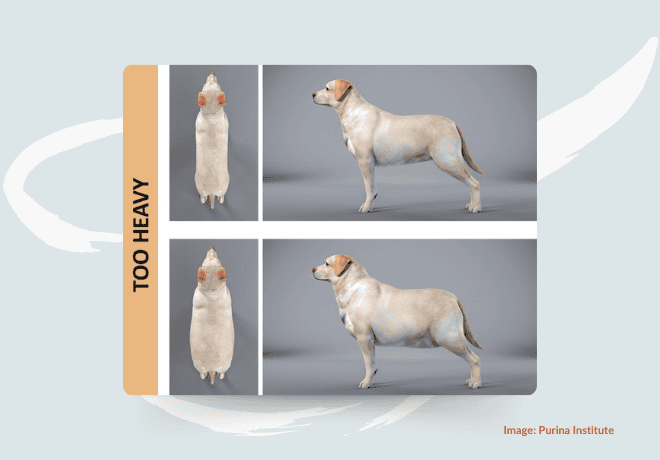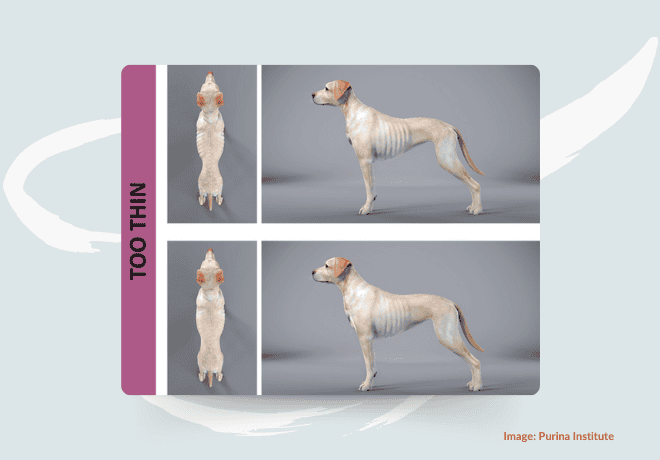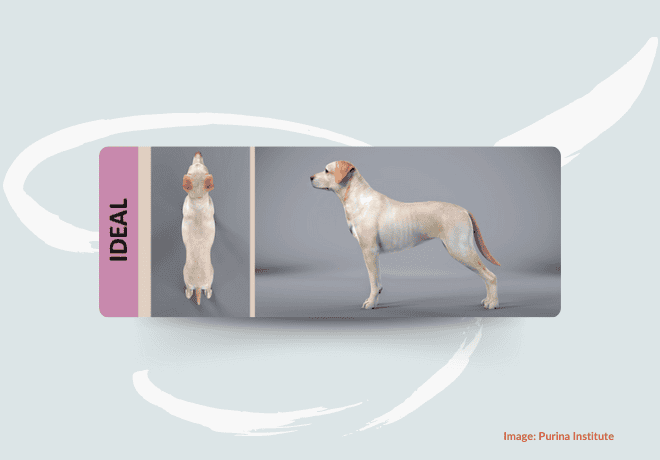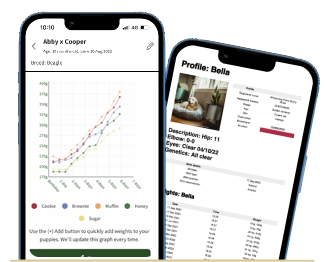Body Condition Score (BSC) is one of the most important tools you can use to monitor and maintain your dog’s health. As responsible breeders, ensuring the health and well-being of your dogs is always the top priority and BCS is a big part of that.
This simple yet effective system helps assess whether a dog is underweight, overweight, or at an ideal weight, ensuring that every dog in your care is healthy, happy, and thriving.
Our partners at Purina have a handy infographic to explain BCS.
Understanding BCS is essential not just for breeders, but also for the new families who will be welcoming your puppies into their homes.
Sharing this knowledge with them can help set your puppies up for a lifetime of good health.
What is the Body Condition Score (BCS)?
The Body Condition Score is a scale used to evaluate a dog’s body fat and overall physical condition.
The most commonly used BCS scale ranges from 1 to 9:
- 1-3: Underweight (too thin)
- 4-5: Ideal weight
- 6-9: Overweight (too heavy)
Each score on the BCS scale corresponds to specific physical characteristics that can help determine whether a dog is maintaining a healthy weight. This system is particularly useful because it takes into account the natural variation in size and shape across different breeds.

Why does Body Condition Score matter for dog breeders?
Maintaining an appropriate BCS is crucial for several reasons:
General health and wellbeing of dogs
Dogs that are underweight or overweight are more susceptible to health issues. Underweight dogs may struggle with malnutrition and weakened immune systems, while overweight dogs are at risk for conditions like diabetes, joint problems, and heart disease.
Breeding dog health
It’s essential for our breeding dogs to be the correct weight and health.
Underweight females may have difficulty carrying a pregnancy to term, and overweight females can experience complications during delivery. A balanced BCS helps ensure that both the dam and sire are in optimal condition for successful breeding and healthy litters.
Pet longevity and quality of life
Dogs with a healthy BCS typically live longer, more active lives. By keeping your breeding dogs and puppies at an ideal weight, you are contributing to their overall longevity and quality of life.

How to assess BCS for your breeding dogs
Assessing a dog’s BCS involves both visual examination and hands-on evaluation.
Here’s a step-by-step guide:
Ribs
Run your hands gently along your dog’s ribcage. At an ideal BCS (4-5), you should be able to feel the ribs without pressing hard, but they should not be visibly protruding. If the ribs are easily felt with no fat covering, the dog may be underweight. If you can’t feel the ribs at all, the dog is likely overweight.
Waistline
Look at your dog from above. An ideal BCS dog will have a visible waistline, with a noticeable tuck behind the ribs. If there’s no visible waist or the dog’s shape is more rounded, they might be overweight. A sharply defined waistline or a sunken abdomen could indicate that the dog is underweight.
Abdominal tuck
View the dog from the side. Behind the ribs, there should be a gentle upward tuck of the abdomen. A flat or bulging abdomen may suggest the dog is overweight, while a pronounced tuck could indicate underweight.

How to educate new pet families about dog weights
As breeders, it’s important to educate new pet families on how to maintain their puppy’s ideal BCS. This knowledge will empower them to keep their new family member healthy throughout their life.
Regular checks
Encourage families to perform regular BCS checks as part of their routine care. This helps them monitor their dog’s weight and make adjustments to diet or exercise as needed.
Balanced diet
Advise families on the importance of a balanced diet that meets their dog’s nutritional needs without overfeeding. Portion control is key to preventing weight gain.
Exercise
Remind families that regular exercise is essential for maintaining a healthy BCS. Whether it’s daily walks, playtime, or agility training, staying active keeps dogs at an ideal weight and improves their overall health.
By regularly assessing BCS, you can ensure your dogs are in peak physical condition, leading to healthier lives and successful breeding outcomes.
Sharing this knowledge with new pet families helps them continue the responsible care you’ve started, ensuring that your puppies grow into healthy, happy dogs.
By keeping BCS top of mind, you’re not just raising dogs—you’re raising the bar for responsible breeding.
Further reading:
American Kennel Club (AKC) – Canine Health Foundation: The AKC provides guidelines on maintaining a healthy weight for dogs and the importance of monitoring BCS.
The Kennel Club (UK) – The Kennel Club provides educational materials on dog health and breeding practices, including the importance of maintaining an ideal BCS.
Breed-specific clubs and organisations – Many breed clubs provide specific guidance on maintaining an ideal BCS for their respective breeds.
Disclaimer:
*The information provided in this article is for general informational purposes only and is not intended to be a substitute for professional veterinary advice, diagnosis, or treatment. The content shared here is based on thorough research, personal experiences and the collective knowledge of the dog breeding community.
While we strive to offer accurate and up-to-date information, the field of veterinary medicine is constantly evolving, and individual cases may vary. Always seek the advice of a qualified veterinarian with any questions you may have regarding your dog’s health or well-being.














By Courtney Farrow
Courtney supports Breedera with all our online content. Specialising in heart-led copywriting for purpose-driven brands, she is passionate about Breedera's mission to make responsible breeding practices easy and rewarding and champion more traceability and transparency in the pet industry.